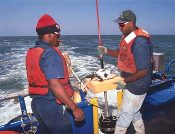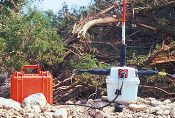Technology at work: Field tested technologies help cut costs
TECHNOLOGY AT WORKNew field-tested technologies help operators cut costs
Covered below are: 1) a unique portable system for directly applying steam and / or hot gas to lower-volume oil wells; 2) a new, proprietary chemical for cost-effective downhole paraffin treatment; 3) a CaCl2 / polymer drilling fluid to control reactive clays in deepwater wells; 4) improved tongs for safer rig-floor operations, plus safety training program tips; 5) universal seismic acquisition to cover diverse land, transition zone and shallow marine environments; and 6) an introduction / overview of how the Petroleum Technology Transfer Council (PTTC) is helping U.S. independents cope in the present "crisis" situation.... Universal seismic acquisition systemJohn Norton, Fairfield Industries Many modern prospects encompass more than a single field setting. It is now commonplace to see prospects covering a combination of land, transition zone and shallow marine environments. Explorationists expect seamless geophysical coverage in these diverse environments. Consistency of subsurface coverage and uniformity of recorded data are conducive to better data quality and faster turnaround in 3-D data processing, resulting in enhanced productivity throughout the exploration cycle. Market forces dictate that seismic acquisition systems be capable of operating in a variety of environmental settings using a common set of field equipment. Contractors cannot afford to hold inventories of seismic systems to suit various exploration environments. A universal acquisition system, which transmits data via radio or cable, or stores data, and works on land, marsh and shallow water without any modification, is the industry demand. This equipment must have the flexibility to operate in whatever mode is appropriate for any given acquisition scenario. For example, radio may be optimum for 50% of a particular patch, cable for 35% and stored data for the remainder. In addition, systems should be able to mix these modes seamlessly, as further patches require. A universal system. Fairfield has developed BOX — The Seismic Data Net. This is a homogeneous acquisition system which, by using the same field equipment, can operate in real-time radio, cable and stored-data modes to capture data across a wide range of field settings. It is no longer necessary for a client to request a variety of field equipment suited to each part of the prospect, nor is it necessary to employ several contractors to acquire separate parts of a prospect just because their equipment is suited to an overall project niche. Contractors are enthusiastic about the new system, because it enables them to reduce capital expenditures and affords them opportunities to tender for a wider range of jobs. Seamless data acquisition. To ensure accurate imaging, the recording patch must cover the full range of environments, so that a seismic source operating in one setting is registered in all others. Proper data matching across various conditions is an essential benefit. Seamless receiver coverage with diverse sources provides sufficient information to derive operators, which may then be applied to pre-stack data. Data matching is performed by forming various algebraic combinations between possible source and receiver pairings. If several sets of instrumentation are used to span various environments, data matching must involve additional complexities of instrument amplitude and phase-response matching. Using a single set of instrumentation would eliminate this complicating factor. Seamless receiver coverage with diverse sources, or "seismic data net," enables correct pre-stack application of all surface-consistent processes, such as deconvolution, statics, amplitude correction and pre-stack migration. A seamless seismic data net also provides enhanced spatial continuity, resulting in even subsurface sampling in terms of both shot and receiver gathers. Common mid-point sampling will be consistent throughout the area, eliminating big changes in fold and offset / azimuth sampling, which could lead to unpredictable acquisition artifacts due to differential noise and multiple attenuation performance. Acquisition example. Consider a Texas Gulf Coast prospect that covers four distinct environmental zones, Fig. 1. To achieve seamless coverage, each acquisition patch will comprise nearly 2,000 live receiver groups. Due to diversity of environments, there will be many occasions when the patch will consist of a mix of geophones and hydrophones registering source data from dynamite and airgun shots, as well as vibroseis points. Careful analysis of potential equipment moves and capacity to roll each patch efficiently places a 5,000-channel inventory requirement on the crew. The northernmost zone in Fig. 1 is clearly a land environment suitable for vibroseis and deployment of cable equipment. Moving south, the next zone encompasses a bay environment. This region, called Laguna Madre, is well known for its oyster beds. Oyster beds and harvesting are notoriously hard on cables, so it is unlikely that a bottom cable technique would be used to record data. Shrimp trawlers can easily damage their equipment, as well as seismic gear, during shrimping season. Fishing activity also contributes to traffic and creates seismic noise. Remote acquisition units, configured as radio telemetry buoys, are the preferred approach. The next zone covers an island. Shot and receiver deployment in this region must contend with a thick marsh environment. Receiver lines are formed using airboats, which provide easy access for placing remote acquisition units; but environmental restrictions limit the maximum number of passes along any shot or receiver line to eight. It is impractical to use hand-placed cable in this area, which can be easily damaged by wildlife. A far better approach is to use radio telemetry. Radio has the added benefit that, unlike cable, failure of any individual remote unit will not affect others along the seismic line.
In the shallow marine zone, water depths range up to 100 ft, making the area well suited to radio telemetry buoys, Fig. 2. It is customary to "swap" receivers for shots. Required subsurface coverage can be met by using highly productive airgun sources. Air is cheap, as the saying goes. Besides higher production rates, there is less equipment, avoiding damage from the elements, fishing and sport activities. To make the best use of this productive environment, remote units should be capable of conveying full-fidelity data in real time to the central recording system. Typically, a single vessel carries both central recording system and seismic source. At 5 kt, airgun operations must maintain a 10-sec cycle between airgun shots to achieve a 25-m shot-point interval. Fortunately, the system can achieve this demanding duty cycle, making it possible to routinely record over 3,000 shots a day. In particularly difficult areas, it is necessary to employ what is commonly known as stored-data mode to remain productive. In such cases, remote units act as local recorders, triggered by a radio command from the central recording system, Fig. 3. Enough remote data storage is provided to amass several days of production. The system’s radio capabilities enable convenient over-air data retrieval, eliminating data retrieval by hand at each remote unit. Heretofore, stored-data operations were "blind," meaning operations continued without secure knowledge that seismic data was being recorded. Reassurance is now provided by reporting seismic trace attributes (selected QC values, such as signal-to-noise and first-break picks) and compressed seismic data back to the central recorder every shot point. Conclusion. Key to the system’s
universal nature is that each remote unit is endowed with radio, cable and stored data
functionality. Each remote unit can take up to eight seismic inputs and convey data to the
central recorder via radio or cable telemetry. The system has the capability to record 8,000
seismic channels in real time at 2-ms sampling, 250,000 channels with cable and virtually
unlimited capacity with the stored data option. This flexible system affords seismic
contractors the adaptability to configure crew assets in the best ways possible for maximum
productivity. Copyright © 1999 World
Oil |
- Applying ultra-deep LWD resistivity technology successfully in a SAGD operation (May 2019)
- Adoption of wireless intelligent completions advances (May 2019)
- Majors double down as takeaway crunch eases (April 2019)
- What’s new in well logging and formation evaluation (April 2019)
- Qualification of a 20,000-psi subsea BOP: A collaborative approach (February 2019)
- ConocoPhillips’ Greg Leveille sees rapid trajectory of technical advancement continuing (February 2019)




